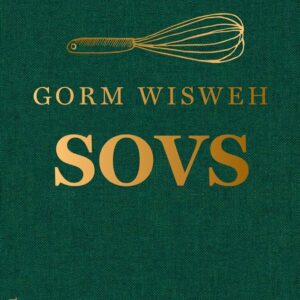A little about sauce
The pride of making the sauce should not be underestimated
BEFORE BED
One of the great moments in my cooking life – and in my life in general – was when, as a ski bum in Alpe d’Huez, I had promised gold and green forests in relation to my skills in a kitchen in order to be hired and get accommodation and a lift pass.
I was hired, employed, and then I was standing there at the legendary Hotel Eclose and had to put funds over, just like I had seen them spinning in my childhood in my father’s and mother’s restaurant in Svaneke. I couldn’t do a damn thing, but I wanted to do it with all my might, threw myself into it and was allowed to. And before long, I was roasting bones, arranging herbs and skimming as if my life depended on it. Well, it kind of did. Well, my life as a ski bum …
One morning I came down to the kitchen and as my foot stepped inside, a really big stock pot came hurtling towards me followed by a rant about what the hell I had been thinking when I had left without turning off the flame the night before.
Two days of painstaking work had burned and charred at the bottom of the pot. I was angry at first and thought it was an overreaction and quite hysterical to get so angry. After all, it was just funds. But having to cook for the next few days without stock was downright awful and a pain in the ass. Especially in a kitchen that was classically French. The food didn’t taste like anything.
The Flying Giant Pot taught me once and for all that stock is the cornerstone, well, the number one ingredient in the sauce kitchen. But over time, I’ve also learned that there are long and short ways to a good fund. Yes, there are probably as many ways, methods and recipes as there are chefs. My funds have always delivered and more. . and that’s all there is to it. And yes, some funds take a long time and are cumbersome. Others are quick and easy.
The problem as a civilian, private home cook is that you rarely have a choice but to make them yourself. What you can buy is shit with shit on it. Salty and over-preserved crap and impossible to use. Which is strange, as many of the same brands you can buy actually make really good foundations for us professionals to buy when we can’t be bothered to make them ourselves. So if you have access to the places where we chefs shop, you can get your hands on some decent meat stock. Otherwise, a good trick is to go to the butcher who makes it in-house – or make a cheeky deal with the local chef/restaurant. In fact, it can often be done.
But the long and short of it is: See if you can’t find the time to start your own fund. Give your fund the love and care it deserves and I promise you – you’ll get it back tenfold when you sit around the table.
STYLES
This is a nerdy cookbook. But be careful, don’t let the fact that you’re missing some detail ingredient stop you from diving into a new sauce. Just get out there and try it out. If you don’t have just the right chili for your pier, you’ll be fine. Use another and see what happens. This is true no matter what type of sauce you’re making. And speaking of types, let’s reverse them.
THE BAKED
Baked sauces are sauces that are based on fat, often butter, and flour. A butter bun to which you add boiling water and then often milk or cream. You can, in theory, bake on all fats. Christmas gravy is made with fat from the bird, roast pork gravy with fat from the pig, etc.
The boiling water is the cooking trick. This causes the flour to dissolve (pre-dissolve) just right, making the sauce smooth, glossy and (hopefully) lump-free. Remember, if you have potato water on the side burner, that’s what you use. Just like grandma did.
BIKE
A velouté is a sauce, but instead of milk and cream, you use broth – I LOVE veloutés! It’s soft, it’s creamy, and if the stock is good, there can be so much flavor.
REAL SAUCE
A real sauce, yes, that’s what they’re called, they’re the ones based on butter and eggs.
GLACE
Glace is the fine, the wild, what we are served at the restaurant. There is concentration and honor in making a good glace. A glace is usually a stock cooked down to an incredibly intense flavor and stirred with lumps of cold butter just before serving. It’s called a fitting. You don’t get a glace in large quantities, it’s simply too powerful and flavorful, it needs to be that little, powerful kick that takes the sting home.
COLD SAUCES AND DRESSINGS
In my world, gravy is not just all things warm and hot. The door to my gastronomic world really opened when I made my first pesto and I haven’t looked back since. So yes, a dressing, tapenade and pesto are also sauces in my world. It’s a great dipping sauce, which is why it’s included in this book.
THE FIVE BASIC SAUSAGES
You can’t write a book about gravy without mentioning these five. Yes, they are important, and they are a good starting point for becoming a sauce king.I’ve learned them peu en peu, to use French chef-speak, a little bit at a time, and I think you should eventually try all five, dear reader.
BECHAMEL
SPANISH
TOMATO
BIKE
GOOD TO KNOW
You can dive right into the book’s recipes, and please do. You may come across a method, ingredient or term you’ve never heard of before when it comes to gravy. It can happen whether you’re reading this book, talking to the chef at your local restaurant or competing with your sauce competitor to be the most on top of things. That’s why I’ve compiled a list below of some things that are good to know, could know, know. In a completely messy order, just like it happens in my head every now and then.
A GASTRIC
You’re bound to meet a home chef who explains how it was the homemade gastrik that saved the sauce. And yes, that may very well be the case. In many sauce recipes you will come across gastrik. It’s not included in this book as a standalone recipe in the recipe section, but in many recipes you’ll actually make a gastrik or something very similar.
Here’s a classic description so you know what it is. And can easily make it. Because it’s incredibly easy. And it keeps for a long time – and is great to keep in the fridge in a small glass.
A gastrik consists of caramelized sugar and vinegar boiled down to a syrup. So you simply caramelize sugar without burning, dissolve the caramel in vinegar and slowly boil it down to a thin syrup. You can also make a good gastrik with red wine instead of vinegar. It goes without saying that a gastrik is a great way to flavor sauces in terms of the balance between sweetness and acidity.
TO PLAY
To play To play means to level/thicken. You can smooth with egg yolk, cream, heavy cream, oil or butter.
TO MASK
Yes, it means exactly what it says. Chefs do it every now and then, and you can use the trick too. When masking, you use the sauce to cover an area of the dish that isn’t quite right. Often if the crust of the meat is not just right, you mask it.
TO LEAN
To leaven is to thicken the sauce by boiling it down or using starch. Or by using some tricks, like when you alloy a sauce. In short, basting is all about getting the consistency of the sauce just right when thickening it.
UMAMI
Sauce is very often what adds umami to the dish. Umami is the fifth basic taste – the other four are salty, sour, sweet and bitter. I often describe umami as the interpreter that makes all the other flavors talk to each other.
FOAMING
When making foundations, it is especially important to remove impurities and egg white substances on an ongoing basis. Mostly at the start of the boil.
To skim is to take a ladle or skimmer and pull it 1 millimeter below the surface of the liquid, trapping the foam and grease that comes to the surface. Otherwise, it will boil back into the fund and create bitterness and cloudiness. So it’s important to skim, both for sight and taste.
JUS
Yeah, maybe you don’t know that one? A jus is a light sauce or broth. In my world, a thin fund. It’s nice here and there, but I rarely use it.
FITTING
Fitting is much the same as playing. Often cold butter is used for assembly in small cubes, but you can also use beef marrow or other solid fat.
REDUCING
It’s simple. When you reduce, you cook the sauce down to concentrate it.
EMULSION
An emulsion is a mixture of two liquid ingredients that would not normally mix. Butter and eggs, vinegar and oil, etc.
WHIPPINGTOUGH
This is especially true when talking about whipping eggs. For example, when you whisk egg yolk with salt, the mixture becomes “long” in consistency and lighter in color. You whip the protein chains together, making them creamier and ready to receive. Often a grease.
SOYBEAN
Soy isn’t just for spring rolls. Feel free to use soy dark sauces as a supplement and as a substitute for salt. It adds an extra kick to the umami side.




